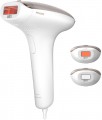Epilator attachments
The number of
attachments supplied with the epilator in standard configuration. A wide variety of attachments allows you to save on the purchase of other body care products (for example, a trimmer or a razor).
Purpose of nozzles
—
For the body. An attachment featuring an enlarged light window, designed for treating larger body areas like the upper and lower limbs, abdomen, and more. This attachment is often curved to ensure optimal skin contact.
—
For the face. The facial attachment typically incorporates a compact flat light window, often accompanied by a red protective filter. Its purpose is to perform hair removal on delicate skin areas like above the upper lip, the chin, and cheekbones.
—
For armpits. With the removal of hard-to-reach hair in the armpit area, a special nozzle for the armpits does a good job. It provides a medium-sized light window, and thanks to the curved shape, the attachment perfectly follows the contours of the body.
—
Bikini area. An attachment equipped with a transparent filter in the light window serves as an efficient solution for treating the bikini area. This filter enhances the treatment's effectiveness on coarse hairs while ensuring dependable protection for sensitive skin.
Power source
Power supply for the epilator.
—
Mains power. Operates through a regular household outlet, offering nearly limitless usage as long as there's a power supply. The downside is mobility constraints due to cord length and dependence on available sockets.
—
Battery. Uses its internal, often non-removable, battery. While this affects weight and cost, it grants the advantage of being usable even without nearby outlets, which proves beneficial during travel and at home. Compared to another autonomous power source—batteries—these batteries are more efficient, suitable for robust and long-lasting devices. Charging is necessary, unlike quick battery replacement, though this isn't a critical concern considering the specific use of epilators.
—
Network/battery. Essentially battery models with the added capability to function using a power outlet. This way, the device can operate autonomously, and when the battery depletes, it can be connected to the mains and resume operations (typically while recharging the battery). Such combined power supply models are less common due to their infrequent necessity.
— Batteries. Reliant on standard replaceable batteries, often AA-sized. A perk of this type is that a drained battery can be swiftly swapped for a fresh one. However, battery performance is relatively limited, influencing the efficiency and lifesp
...an of epilators. This approach can lead to ongoing expenses for fresh batteries, unless rechargeable batteries are used (along with a charger, which might be costly). Consequently, this option is less common, primarily seen in inexpensive models.Charging time
What is the duration required to fully charge the epilator battery from complete discharge to 100%? If the battery usage is limited to home use for convenience, the charging duration might not be extremely important. However, if the device is frequently carried during trips, it's advisable to consider models with a shorter charging time.
Operating time
The lamp's photoepilator (refer to "Type") can generate a certain quantity of flashes on a single battery charge. A longer operation time results in an extended battery life, reducing the frequency of recharging.

